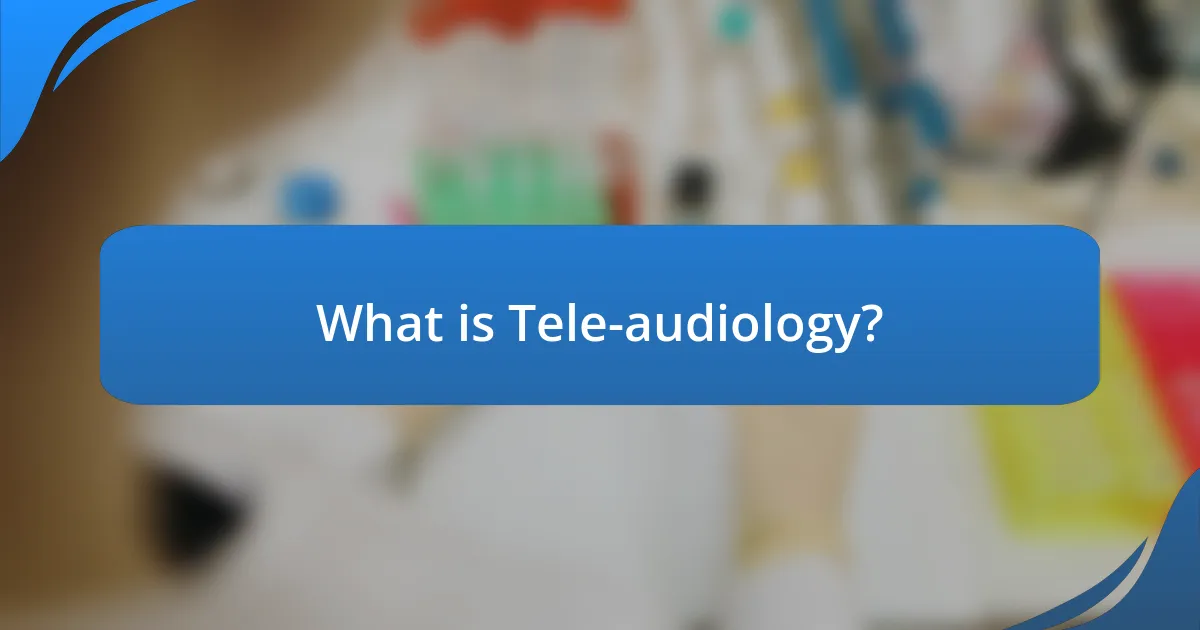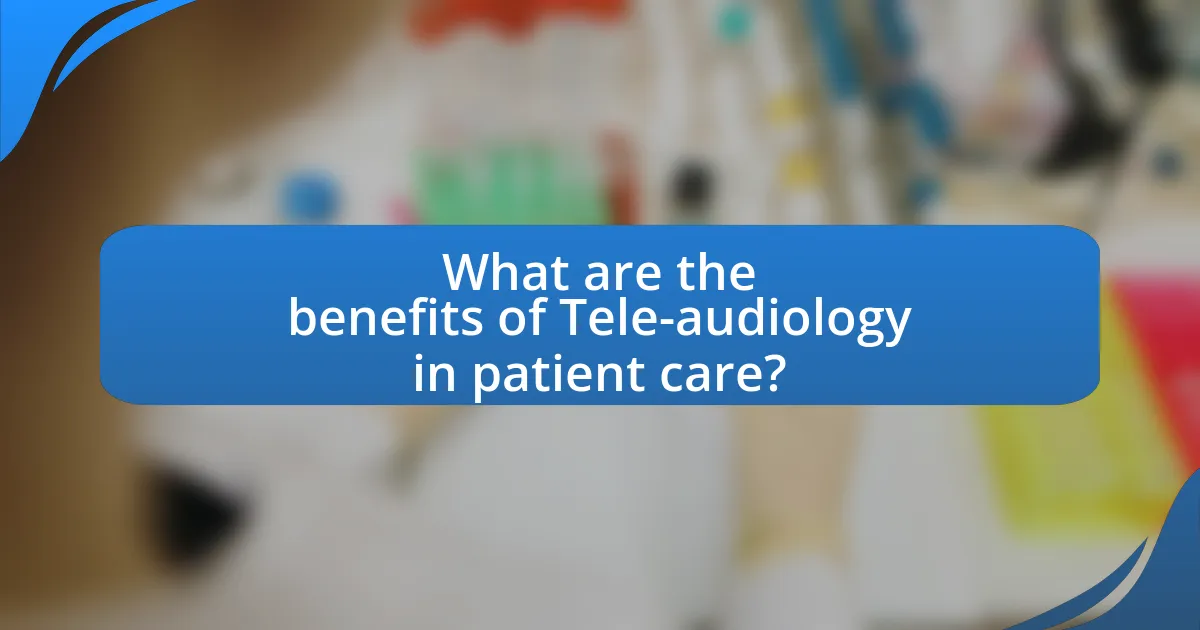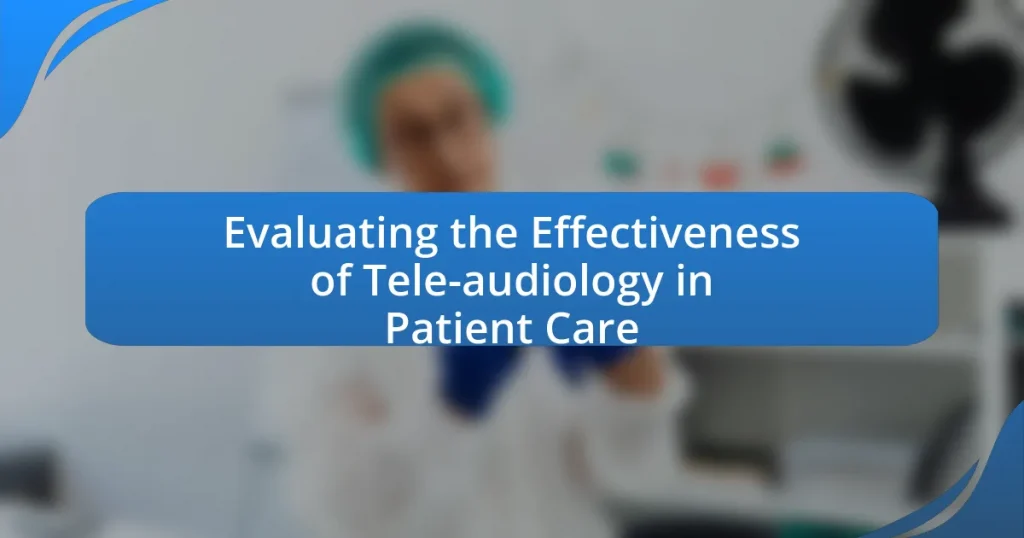Tele-audiology is a branch of audiology that leverages telecommunication technology to deliver audiological services remotely, enhancing accessibility for patients, particularly in rural or underserved areas. The article evaluates the effectiveness of tele-audiology in patient care, discussing its operational mechanisms, the technologies employed, and the roles of audiologists in facilitating remote assessments and consultations. It highlights the benefits of tele-audiology, including improved patient engagement, satisfaction, and treatment outcomes, while also addressing challenges such as technological barriers and regulatory concerns. Additionally, the article explores future prospects and innovations in tele-audiology, emphasizing the impact of patient preferences and healthcare policies on its expansion.

What is Tele-audiology?
Tele-audiology is a branch of audiology that utilizes telecommunication technology to provide audiological services remotely. This approach allows audiologists to conduct assessments, consultations, and follow-up care without the need for in-person visits, thereby increasing accessibility for patients, especially those in remote or underserved areas. Research indicates that tele-audiology can effectively deliver services comparable to traditional methods, as evidenced by studies showing similar patient outcomes and satisfaction levels.
How does Tele-audiology function in patient care?
Tele-audiology functions in patient care by providing remote audiological assessments and consultations through digital platforms. This approach allows audiologists to evaluate hearing loss, fit hearing aids, and provide follow-up care without the need for in-person visits. Research indicates that tele-audiology can improve access to care, particularly for patients in rural or underserved areas, and has been shown to yield comparable outcomes to traditional face-to-face consultations. For instance, a study published in the Journal of Telemedicine and Telecare found that tele-audiology services resulted in high patient satisfaction and effective management of hearing conditions, demonstrating its efficacy in enhancing patient care.
What technologies are utilized in Tele-audiology?
Tele-audiology utilizes various technologies including video conferencing platforms, remote audiometric testing devices, and mobile health applications. Video conferencing platforms enable real-time consultations between audiologists and patients, facilitating communication and assessment. Remote audiometric testing devices allow patients to conduct hearing tests in their own environment, ensuring accurate results. Mobile health applications support patient engagement and monitoring by providing access to hearing health resources and enabling tracking of hearing-related data. These technologies collectively enhance the accessibility and effectiveness of audiology services, as evidenced by studies showing improved patient outcomes and satisfaction in tele-audiology settings.
How do these technologies enhance patient interactions?
Tele-audiology technologies enhance patient interactions by facilitating real-time communication and personalized care. These technologies enable audiologists to conduct remote consultations, allowing patients to receive timely assessments and follow-ups without the need for in-person visits. Research indicates that tele-audiology can improve patient satisfaction and engagement, as evidenced by a study published in the Journal of Telemedicine and Telecare, which found that 85% of patients reported a positive experience with remote audiology services. This increased accessibility and convenience lead to better adherence to treatment plans and improved health outcomes.
What are the key components of Tele-audiology?
The key components of Tele-audiology include remote hearing assessments, virtual consultations, and the use of digital technology for hearing aid fittings and adjustments. Remote hearing assessments allow audiologists to evaluate patients’ hearing remotely, utilizing specialized software and equipment. Virtual consultations facilitate real-time communication between audiologists and patients, enabling discussions about hearing health and treatment options. Digital technology plays a crucial role in fitting and adjusting hearing aids, allowing audiologists to program devices remotely, ensuring patients receive timely and effective care. These components collectively enhance accessibility and efficiency in audiology services.
What roles do audiologists play in Tele-audiology?
Audiologists in Tele-audiology primarily conduct remote assessments, provide consultations, and offer rehabilitation services to patients with hearing and balance disorders. They utilize technology to perform hearing evaluations, interpret results, and recommend appropriate interventions, ensuring continuity of care. Research indicates that Tele-audiology can effectively deliver services, with studies showing comparable outcomes in patient satisfaction and hearing aid fitting success rates when compared to traditional in-person visits.
How do patients engage with Tele-audiology services?
Patients engage with Tele-audiology services primarily through virtual consultations, which allow them to receive audiological assessments and follow-up care remotely. This engagement typically involves using video conferencing tools or mobile applications to connect with audiologists, enabling real-time communication and evaluation of hearing health. Research indicates that 85% of patients report satisfaction with Tele-audiology services, highlighting their effectiveness in providing accessible care while reducing travel time and associated costs.
What challenges does Tele-audiology face?
Tele-audiology faces several challenges, including technological barriers, patient engagement issues, and regulatory constraints. Technological barriers arise from the need for reliable internet access and appropriate devices, which can limit service delivery in rural or underserved areas. Patient engagement issues stem from varying levels of comfort with technology among patients, which can affect their willingness to participate in remote consultations. Regulatory constraints include differing state and federal laws regarding telehealth practices, which can complicate the provision of services across state lines. These challenges can hinder the overall effectiveness of tele-audiology in patient care.
What are the common technical issues encountered?
Common technical issues encountered in tele-audiology include connectivity problems, audio quality issues, and software compatibility challenges. Connectivity problems often arise due to unstable internet connections, which can disrupt communication between patients and audiologists. Audio quality issues may stem from inadequate microphones or speakers, leading to unclear sound transmission. Software compatibility challenges occur when different systems or applications used by patients and providers do not integrate smoothly, hindering effective consultations. These issues can significantly impact the overall effectiveness of tele-audiology services, as highlighted in studies examining patient experiences and outcomes in remote audiology care.
How do regulatory and privacy concerns impact Tele-audiology?
Regulatory and privacy concerns significantly impact Tele-audiology by imposing strict guidelines that healthcare providers must follow to ensure patient confidentiality and data security. These regulations, such as the Health Insurance Portability and Accountability Act (HIPAA) in the United States, require that patient information be protected during remote consultations, which can limit the types of technologies and platforms that audiologists can use. Additionally, compliance with these regulations often necessitates additional training for practitioners and may lead to increased operational costs, ultimately affecting the accessibility and efficiency of Tele-audiology services. The necessity for secure communication channels and data storage solutions can also hinder the rapid adoption of Tele-audiology, as providers must ensure that their practices align with legal standards to avoid potential penalties.

What are the benefits of Tele-audiology in patient care?
Tele-audiology enhances patient care by increasing accessibility, improving patient engagement, and providing timely interventions. Patients can receive audiological services remotely, eliminating geographical barriers and reducing travel time, which is particularly beneficial for those in rural or underserved areas. Studies indicate that tele-audiology can lead to higher patient satisfaction rates, as it allows for more flexible scheduling and convenience. Additionally, remote monitoring and follow-up can facilitate quicker adjustments to hearing aids or treatment plans, ensuring that patients receive optimal care without unnecessary delays.
How does Tele-audiology improve access to care?
Tele-audiology improves access to care by enabling remote consultations and assessments for patients with hearing issues, eliminating geographical barriers. This technology allows audiologists to provide services to individuals in rural or underserved areas, where access to specialized care may be limited. A study published in the Journal of Telemedicine and Telecare found that tele-audiology services increased patient engagement and satisfaction, demonstrating that patients were more likely to seek care when it was accessible from their homes. Additionally, tele-audiology can reduce wait times for appointments, further enhancing access to timely care.
What populations benefit most from Tele-audiology services?
Populations that benefit most from Tele-audiology services include individuals in rural or underserved areas, elderly patients with mobility challenges, and those with hearing impairments who require regular follow-up care. Rural residents often lack access to specialized audiology services, making Tele-audiology a crucial resource for them. Elderly patients may face difficulties traveling to appointments, and Tele-audiology provides a convenient alternative for ongoing management of their hearing health. Additionally, studies indicate that Tele-audiology can improve access to care and patient satisfaction, particularly for those needing frequent monitoring or adjustments to hearing devices.
How does Tele-audiology reduce travel and associated costs for patients?
Tele-audiology reduces travel and associated costs for patients by enabling remote consultations and assessments, eliminating the need for physical travel to healthcare facilities. This approach allows patients to receive audiological services from the comfort of their homes, significantly decreasing expenses related to transportation, accommodation, and time off work. A study published in the “Journal of Telemedicine and Telecare” found that tele-audiology can reduce travel costs by up to 80%, demonstrating its effectiveness in making audiological care more accessible and affordable for patients.
What impact does Tele-audiology have on patient outcomes?
Tele-audiology significantly improves patient outcomes by enhancing access to audiological services and facilitating timely interventions. Studies indicate that patients utilizing tele-audiology experience higher satisfaction rates, improved hearing aid fitting, and better adherence to follow-up appointments. For instance, a systematic review published in the Journal of Telemedicine and Telecare found that tele-audiology services led to a 30% increase in patient engagement compared to traditional in-person visits. This increased engagement correlates with better overall hearing health management and outcomes for patients.
How does Tele-audiology affect patient satisfaction levels?
Tele-audiology significantly enhances patient satisfaction levels by providing convenient access to audiological services. Research indicates that patients utilizing tele-audiology report higher satisfaction due to reduced travel time, increased flexibility in scheduling appointments, and the comfort of receiving care in their own environment. A study published in the Journal of Telemedicine and Telecare found that 85% of patients expressed satisfaction with tele-audiology services, citing ease of communication and effective care as key factors. This demonstrates that tele-audiology not only meets patient needs but also improves overall satisfaction with audiological care.
What evidence supports the effectiveness of Tele-audiology in treatment outcomes?
Tele-audiology has been shown to be effective in improving treatment outcomes for patients with hearing loss. A systematic review published in the Journal of Telemedicine and Telecare found that tele-audiology services resulted in comparable patient satisfaction and hearing outcomes to traditional in-person consultations. Additionally, a study by McGarrigle et al. (2020) demonstrated that remote hearing assessments and fittings led to similar audiometric results as face-to-face appointments, indicating that tele-audiology can effectively meet patient needs. Furthermore, a randomized controlled trial in the International Journal of Audiology reported that patients receiving tele-audiology services experienced significant improvements in hearing aid use and overall quality of life, reinforcing the modality’s effectiveness in treatment outcomes.
How does Tele-audiology compare to traditional audiology?
Tele-audiology offers remote audiological services through digital platforms, while traditional audiology requires in-person consultations. Tele-audiology enhances accessibility, allowing patients in remote areas to receive care without traveling, which is supported by a study from the American Journal of Audiology that found tele-audiology to be effective in diagnosing hearing loss with comparable outcomes to in-person assessments. Additionally, tele-audiology can reduce wait times for appointments, as evidenced by a survey indicating that patients experienced shorter delays in receiving care compared to traditional methods.
What are the differences in patient experience between Tele-audiology and in-person visits?
Tele-audiology offers a different patient experience compared to in-person visits primarily in terms of convenience, accessibility, and interaction quality. Patients using tele-audiology often report greater ease of scheduling and reduced travel time, which can enhance overall satisfaction. A study published in the Journal of Telemedicine and Telecare found that 85% of patients preferred telehealth for follow-up appointments due to these factors. However, in-person visits allow for more comprehensive physical examinations and immediate hands-on assessments, which some patients find reassuring. Research indicates that while tele-audiology can effectively address many auditory concerns, certain complex cases may benefit from the tactile feedback and personal interaction available during in-person consultations.
How do treatment protocols differ in Tele-audiology versus traditional settings?
Treatment protocols in Tele-audiology differ from traditional settings primarily in their delivery method and patient interaction. In Tele-audiology, services are provided remotely using digital platforms, allowing for real-time consultations and assessments, while traditional settings involve in-person visits for evaluations and treatments. Tele-audiology protocols often incorporate remote monitoring tools and mobile applications to track patient progress, which contrasts with the hands-on approach of traditional audiology that relies on direct physical examinations and face-to-face interactions. Studies have shown that Tele-audiology can effectively deliver care comparable to traditional methods, with research indicating similar patient outcomes in hearing assessments and management, thus validating the efficacy of remote treatment protocols.

What are the future prospects of Tele-audiology?
The future prospects of Tele-audiology are promising, with advancements in technology and increasing acceptance among healthcare providers and patients. The integration of artificial intelligence and machine learning into tele-audiology platforms is expected to enhance diagnostic accuracy and personalize treatment plans. A study published in the Journal of Telemedicine and Telecare found that tele-audiology services can improve access to care, particularly in rural areas, where traditional audiology services are limited. Additionally, the COVID-19 pandemic has accelerated the adoption of telehealth services, including tele-audiology, leading to a sustained increase in remote consultations and follow-ups. This trend indicates a growing recognition of tele-audiology as a viable alternative to in-person visits, ultimately improving patient outcomes and satisfaction.
How is technology evolving to enhance Tele-audiology?
Technology is evolving to enhance Tele-audiology through advancements in digital communication, artificial intelligence, and remote diagnostic tools. Digital communication platforms enable real-time consultations between audiologists and patients, improving accessibility and convenience. Artificial intelligence algorithms are being integrated into hearing assessments, allowing for more accurate diagnosis and personalized treatment plans. Additionally, remote diagnostic tools, such as smartphone applications and connected hearing devices, facilitate self-monitoring and data collection, which can be analyzed by audiologists to tailor interventions. These innovations collectively improve patient outcomes and streamline the delivery of audiological care.
What innovations are on the horizon for Tele-audiology services?
Innovations on the horizon for Tele-audiology services include the integration of artificial intelligence for enhanced diagnostic accuracy and remote monitoring capabilities. AI algorithms can analyze patient data to identify hearing issues more effectively, as evidenced by studies showing improved detection rates when AI is utilized in audiological assessments. Additionally, advancements in telecommunication technology, such as 5G, will facilitate real-time consultations and high-quality audio streaming, thereby improving patient experience and outcomes. Research indicates that these technological enhancements can lead to more personalized care and better adherence to treatment plans, ultimately benefiting patient health in the realm of audiology.
How might artificial intelligence play a role in Tele-audiology?
Artificial intelligence can enhance tele-audiology by enabling automated hearing assessments and personalized treatment recommendations. AI algorithms analyze patient data, such as audiograms and speech recognition scores, to identify hearing loss patterns and suggest appropriate interventions. For instance, a study published in the Journal of the American Academy of Audiology demonstrated that AI-driven tools could accurately predict hearing aid fitting outcomes, improving patient satisfaction and outcomes. This integration of AI in tele-audiology not only streamlines the diagnostic process but also facilitates remote monitoring and follow-up care, ultimately leading to more effective patient management.
What trends are shaping the future of Tele-audiology?
Tele-audiology is being shaped by several key trends, including advancements in technology, increased patient demand for remote services, and the integration of artificial intelligence. Technological advancements, such as improved internet connectivity and the development of specialized audiology software, facilitate high-quality remote assessments and consultations. The COVID-19 pandemic has accelerated patient demand for telehealth services, with a significant increase in virtual appointments reported; for instance, a study published in the Journal of Telemedicine and Telecare indicated a 200% rise in telehealth visits during the pandemic. Additionally, the integration of artificial intelligence in tele-audiology enhances diagnostic accuracy and personalized treatment plans, as AI algorithms can analyze patient data more efficiently. These trends collectively indicate a transformative shift towards more accessible and effective audiological care.
How are patient preferences influencing Tele-audiology practices?
Patient preferences are significantly influencing Tele-audiology practices by driving the demand for more accessible and personalized hearing care solutions. As patients increasingly favor remote consultations due to convenience and reduced travel, Tele-audiology services are adapting to incorporate user-friendly technologies and flexible scheduling options. Research indicates that 70% of patients prefer virtual appointments for follow-ups, highlighting a shift towards digital platforms that cater to individual needs. This preference is prompting audiologists to enhance their telehealth offerings, ensuring they align with patient expectations for quality care and accessibility.
What role do healthcare policies play in the expansion of Tele-audiology?
Healthcare policies significantly influence the expansion of Tele-audiology by establishing regulatory frameworks, reimbursement guidelines, and standards of care. These policies facilitate the integration of Tele-audiology into mainstream healthcare by ensuring that services are covered by insurance, which encourages providers to adopt telehealth technologies. For instance, the Centers for Medicare & Medicaid Services (CMS) expanded reimbursement for telehealth services during the COVID-19 pandemic, leading to a substantial increase in Tele-audiology consultations. This policy shift not only improved access to audiological care for patients in remote areas but also validated the efficacy of remote assessments, thereby promoting further investment and innovation in Tele-audiology services.
What best practices should be followed in Tele-audiology?
Best practices in Tele-audiology include ensuring high-quality audio and video connections, maintaining patient confidentiality, and providing clear instructions for technology use. High-quality connections are crucial as they facilitate accurate assessments and effective communication, which are essential for diagnosing hearing issues. Protecting patient confidentiality aligns with HIPAA regulations, ensuring that sensitive information remains secure during virtual consultations. Clear instructions help patients navigate the technology, reducing frustration and enhancing the overall experience. These practices contribute to the effectiveness of Tele-audiology in delivering patient care.
How can audiologists ensure effective communication in Tele-audiology?
Audiologists can ensure effective communication in Tele-audiology by utilizing clear audio-visual technology, which enhances patient engagement and understanding. By employing high-quality video conferencing tools, audiologists can facilitate real-time interactions that mimic in-person consultations, allowing for better observation of non-verbal cues and immediate feedback. Research indicates that effective communication in Tele-audiology leads to improved patient satisfaction and adherence to treatment plans, as evidenced by a study published in the Journal of Telemedicine and Telecare, which found that 85% of patients reported satisfaction with remote consultations.
What strategies can enhance patient engagement in Tele-audiology?
Strategies that can enhance patient engagement in Tele-audiology include personalized communication, interactive technology, and educational resources. Personalized communication fosters a stronger connection between audiologists and patients, as tailored messages can address individual needs and preferences. Interactive technology, such as mobile applications and virtual reality, can make the experience more engaging and allow patients to actively participate in their care. Educational resources, including webinars and informational videos, empower patients with knowledge about their conditions and treatment options, leading to increased involvement in their healthcare decisions. These strategies have been shown to improve patient satisfaction and adherence to treatment plans, ultimately enhancing the effectiveness of Tele-audiology services.


